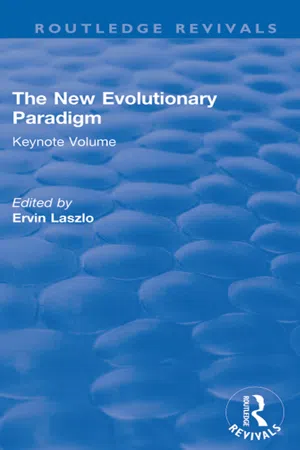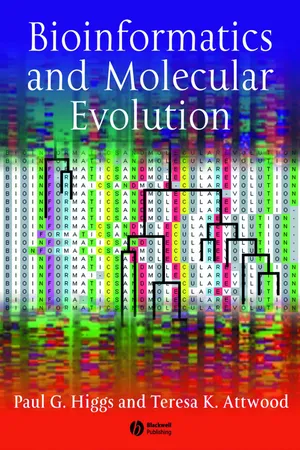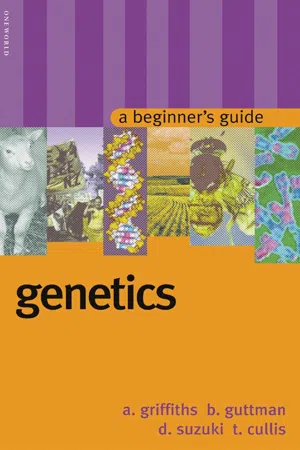Biological Sciences
Evolutionary Changes
Evolutionary changes refer to the gradual modifications in the genetic makeup of a population over successive generations. These changes can result from natural selection, genetic drift, mutation, and gene flow, leading to the emergence of new species and the adaptation of existing ones to their environments. Understanding evolutionary changes is fundamental to comprehending the diversity of life on Earth.
Written by Perlego with AI-assistance
Related key terms
4 Key excerpts on "Evolutionary Changes"
- eBook - ePub
The New Evolutionary Paradigm
Keynote Volume
- Ervin Laszlo(Author)
- 2019(Publication Date)
- Routledge(Publisher)
CHAPTER 3Biological Evolution: The Changing Image
Gianluca BocchiEditor’s Introduction: In the traditional and still dominant conception evolution is a biological concept, denoting the sequential, constant, and presumably gradual development of species from common primeval origins. This Darwinian idea is now seriously debated in regard to a number of particulars. The debates center on issues such as continuity vs. discontinuity, gradualism vs. saltatory dynamics, the role of chance and of necessity, and the importance of natural selection.Bocchi reviews the main positions in these debates. The review throws light not only on the nature of biological evolution, the prima facie objective of the debates, but also on evolution as a general phenomenon. Especially noteworthy in the context of general theory are the emerging insights concerning the blending of indeterminacy and determinacy (or “chance and necessity”) in the post-Darwinian—and also post-Monod conceptions, the discontinuities and leaps that intervene in the evolution of species, and the aleatory spread of mutants during processes of speciation.As the various contributions to this volume testify, many of the new positions in the debates on biological evolution dovetail with conclusions that flow from independently researched fields. Bocchi’s review of the state of the art in biology thus contributes to our understanding of the multiple strands of consistency that now emerge between fields as diverse as macroevolution theory, nonequilibrium thermodynamics, complex dynamical systems theory, learning theory, and the study of patterns of development in history.Chance and Constraint
Among the problems which have historically been of the greatest interest in the study of new evolutionary theories, the nature of novelty and creativity in biological evolution occupies an important place. This problem gave rise to sharp controversies among supporters of the Neo-Darwinian synthesis. In advancing the hypothesis that the already identified micro-evolutionary mechanisms and evolutionary mechanisms as a whole are identical, the Neo-Darwinian synthesis tended toward a mode of thought we can best characterize as “promissory.” The identification of what was termed the central nucleus of the paradigm was held to suffice, during a longer or shorter interval, to thoroughly explain phenomena in all their multiplicity and variety. This created a substantial depreciation of the value of actual and future study, as epitomized in Jacques Monod’s famous affirmation: “today we can affirm that the elementary mechanisms of evolution are not only comprehended in their general lines, but also identified with precision. … As far as the essential lines are concerned, the problem has been … resolved and evolution is no longer at the frontiers of knowledge” (Monod 1970, It. trans. 1970, p. 114). - eBook - ePub
- Paul G. Higgs, Teresa K. Attwood(Authors)
- 2013(Publication Date)
- Wiley-Blackwell(Publisher)
You may know of other definitions of life, or be able to come up with one of your own. One reason we like this one is that it underlines the importance of evolution in biology by including it in the very definition of life. Of course, this begs the question of how to define evolution.Most people have an intuitive idea of what is meant by evolution, and are familiar with phrases like “survival of the fittest”. Everyone also knows that modern ideas of evolution can be traced back to Charles Darwin, whose famous book On the Origin of Species by Means of Natural Selection appeared in 1859. Take a few moments now to think about what the word evolution means to you. Try to write down a definition of evolution in one or two sentences, in a form that would be suitable for use in a glossary of a scientific textbook. When you have done this, read on.A definition that is often found in genetics textbooks is that evolution is a “change in frequency of genes in a population”. While it is true that when a new variant of a gene spreads through a population, the population will have evolved, this definition does not really seem to get to the heart of the matter. Another one we came across is that evolution is “heritable changes in a population over many generations”. This seems closer to the mark, but we are not quite satisfied with it. We would like to suggest that the following two points are the essential factors that define evolution: (i) error-prone self-replication; (ii) variation in success at self-replication.By “self-replication”, we mean that whatever is evolving must have the ability to make copies of itself. Evolution is not simply change. For example, changes that occur during the lifetime of an organism, such as the development of an embryo, aging processes, or the occurrence of mutations in non-germline cells, do not count as evolution. Dawkins (1976) uses the term “replicator” to describe a thing that can self-replicate. Clearly genes can self-replicate, at least in the context of the cell in which they occur. Asexual organisms like bacteria can self-replicate – when a bacterial cell divides, two cells are produced having all the same essential components as the original cell in roughly the same quantities. Sexual organisms like people can also self-replicate in a sense – the offspring of two people is recognizably another person. However, the situation is complicated by the mixing of genes from both parents into one offspring. For this reason, Dawkins (1976) makes a good case for considering genes rather than organisms as the fundamental replicators in biology. - eBook - ePub
Genetics
A Beginner's Guide
- Burton Guttman, Anthony Griffiths, David Suzuki, Tara Cullis(Authors)
- 2002(Publication Date)
- Oneworld Publications(Publisher)
Biston betularia ) became very dark in industrial regions where the trees turned dark from pollution (which killed the light-colored lichens on the bark), so they were well camouflaged. As the pollution was eliminated, the lichens grew again, the trees turned light again, and so did the moths.Cases of more “natural” evolution have also been observed. A good example is the adaptive radiation of Anolis lizards introduced into certain islands of the Caribbean. And Peter and Rosemary Grant have observed that populations of ground finches (Geospizinae, now called “Darwin’s finches”) of the Galapagos Islands undergo heritable adaptive changes, as in the shapes of their bills, in response to severe environmental changes such as periods of drought and extreme storms. These small changes show how even very small genetic differences can be adaptive.evolution as a process
From a broad perspective, evolution entails three processes: macroevolution, speciation, and microevolution. Macroevolution means the large-scale changes observable in the fossil record, which shows that vastly different types of organisms have existed in the past and have replaced one another right up to the present. Speciation means the formation of two or more distinct species in place of one ancestral species. Microevolution means much smaller changes within a single species. This naturally raises the question of what a species is. There is no simple answer. It clearly means a “kind” of organism, but a glance at any book about trees, flowers, birds, insects, or any other organisms will show that many forms designated distinct species are very similar to one another. So how are the lines to be drawn? The simple (and highly debatable) answer is that for sexual organisms the line is drawn at reproduction: all the members of a single species are potentially capable of breeding with one another, but they cannot reproduce with members of other species. Sometimes the members of a species can look - eBook - ePub
The Self-organizing Polity
An Epistemological Analysis Of Political Life
- Laurent Dobuzinskis(Author)
- 2019(Publication Date)
- Routledge(Publisher)
1 being a notable exception. Ever since Darwin's time, theories of biological evolution have given rise to so many instances of misunderstanding and misuse (e.g., Social Darwinism) that a detour through the life sciences is required in order to clear the way for a discussion of societal evolution. While I do not disagree with Coming's thesis that "Darwinian teleology" together with the paradigmatic notion of synergism—i.e., the combinatorial or cooperative effects that facilitate survival and reproduction—can explain evolutionary change, including political development, my strategy here is somewhat different. I argue that biological evolution, systemic differentiation and growth are isomorphic processes answering to an overarching logic, namely the ontogeny (i.e., individual development) of autopoietic unities. Evolution is the history of the sequential reproduction of living systems:what evolves is pattern of autopoietic realization embodied in many particular variations . . . thus, the individuals, though transitory, are essential, not dispensable, because they constitute a necessary condition for the existence of the historical network which they define. The species is only an abstract entity in the present, and although it represents a historical phenomenon, it does not constitute a generative factor in the phenomenology of evolution, it is its result.2Some biologists may feel uncomfortable with this position, but I consider it to be sound from an epistemological standpoint. The first section conveys the concerns of those authors who think that evolution is not simply a matter of "chance and necessity," as Jacques Monod said, but is influenced also by the active development of autonomous living beings. While these ideas may not be consistent with the most dogmatic interpretations of contemporary genetic theories, they are not meant to be a reappropriation, and even less a vindication of Lamarckism.The significance of this paradigm is that it opens onto the socio-cultural level and thus enables us to recover the once discredited concept of societal evolution. The second section illustrates how the latter allows us to pose the problem of social change in terms of the actuation of human potentials, often mediated by political communications, and critically re-interpreted by social theory.The Dialectic of Order and Disorder in Nature: The Production and Reproduction of Life
Our previous discussion of the creative function of disorder points toward an underlying logic of historical change. I use the term "logic" to underline the abstractness of such an approach. A process remains an abstraction as long as it cannot be shown to manifest itself, to borrow a phrase from A.N. Whitehead, in "occasions of experience" for the observer. Only structures, as defined earlier, have a concrete existence and can be located in space and time. "Experiences" are occasioned by the interaction of structures; immanent dynamic processes are either imaginatively created informing our perception of concrete realities or inferred a posteri. This does not mean that science should only be concerned with "things," a view severely criticized by C.H. Waddington,3 but rather that processes always need to be contextualized; or, as Whitehead has put it, even though an occasion of experience is related through space and time to everything else, its specificity depends on a limited set of constituent factors, which he called its "concrescence."4
Learn about this page
Index pages curate the most relevant extracts from our library of academic textbooks. They’ve been created using an in-house natural language model (NLM), each adding context and meaning to key research topics.



